Abstract
Characterization of group A beta-haemolytic streptococci in upper respiratory tract isolates from the USA and Thailand revealed that whereas 80% of the U.S. isolates could be M or opacity factor (OF) typed, less than 20% of the Thai isolates could be characterized with the available typing sera (P less than 0.001). There was also a statistically significant difference observed in the percentage of strains that could be characterized by the T-agglutination pattern (93% in the USA vs 61% in Thailand, P less than 0.001). Even among the identifiable strains, marked differences in the distribution of the recovered serotypes were noted between the two countries. These results show that there are a significant number of as yet unidentified group A streptococcal strains in parts of the world where streptococcal infections and their sequelae are important public health problems. They further imply that such findings must be taken into consideration in the future when designing possible streptococcal vaccines for worldwide use.
Full text
PDF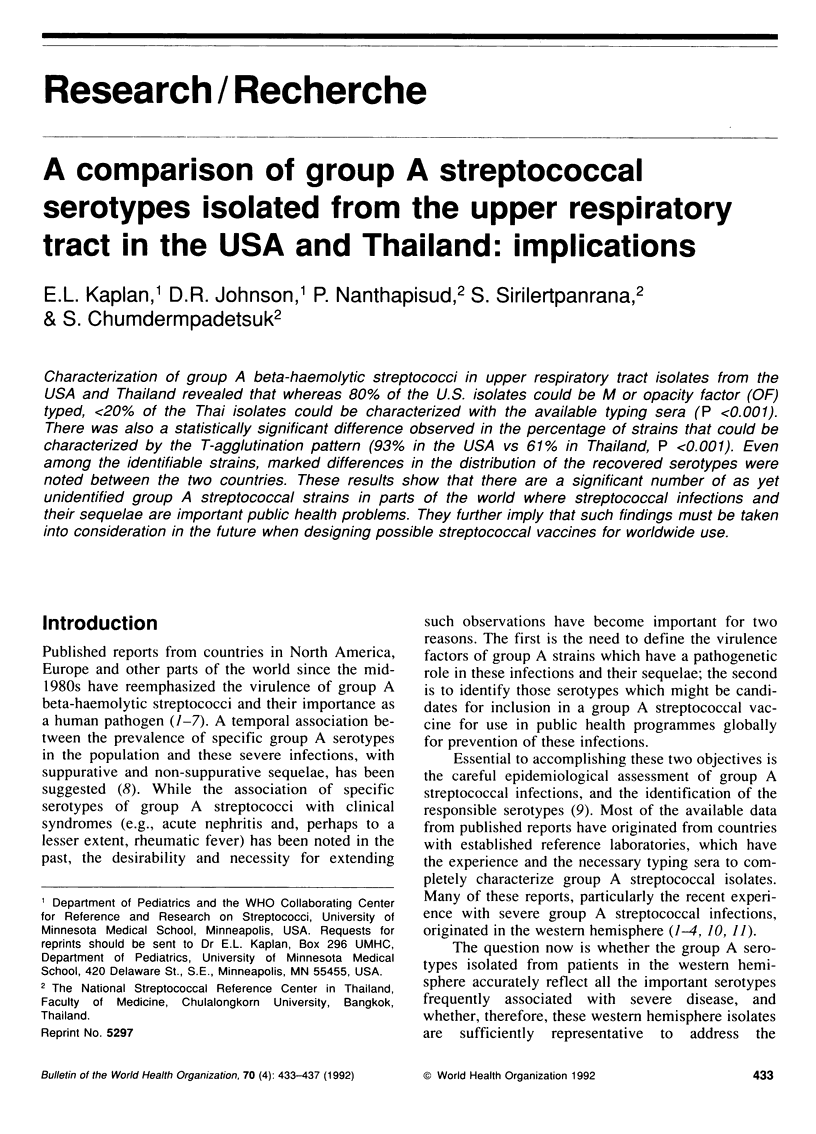
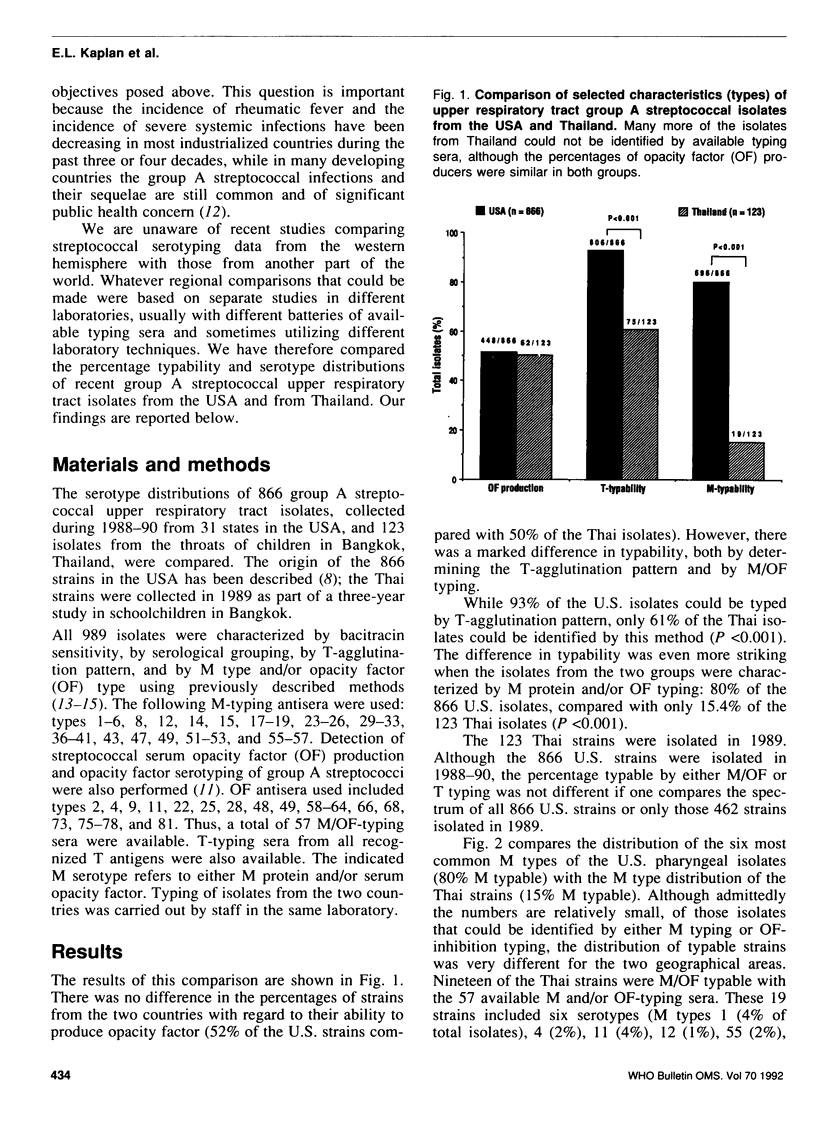
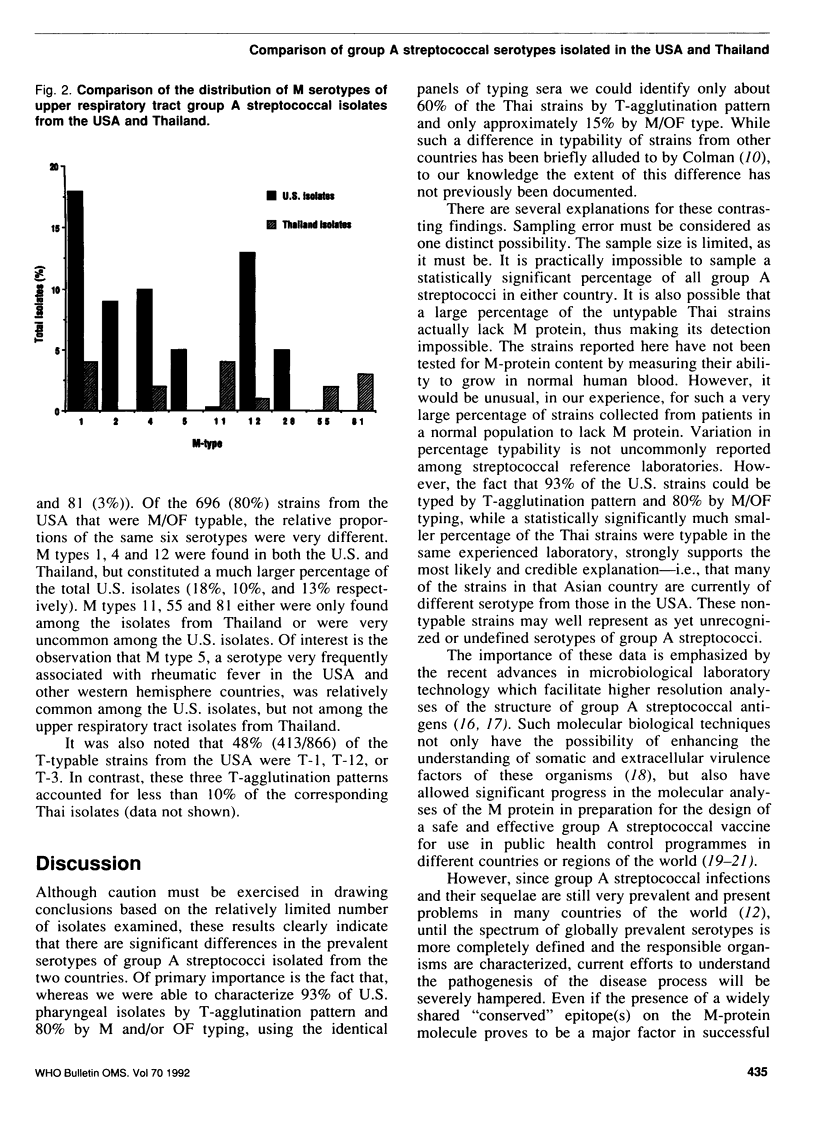
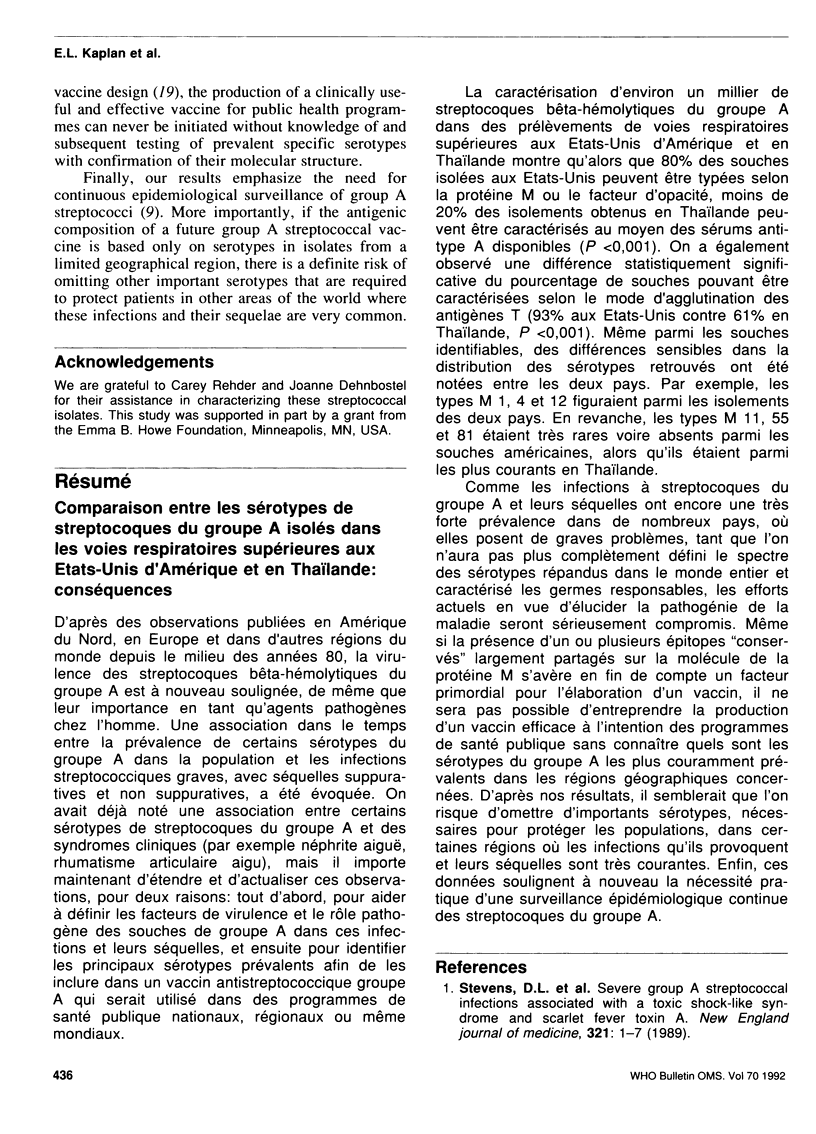
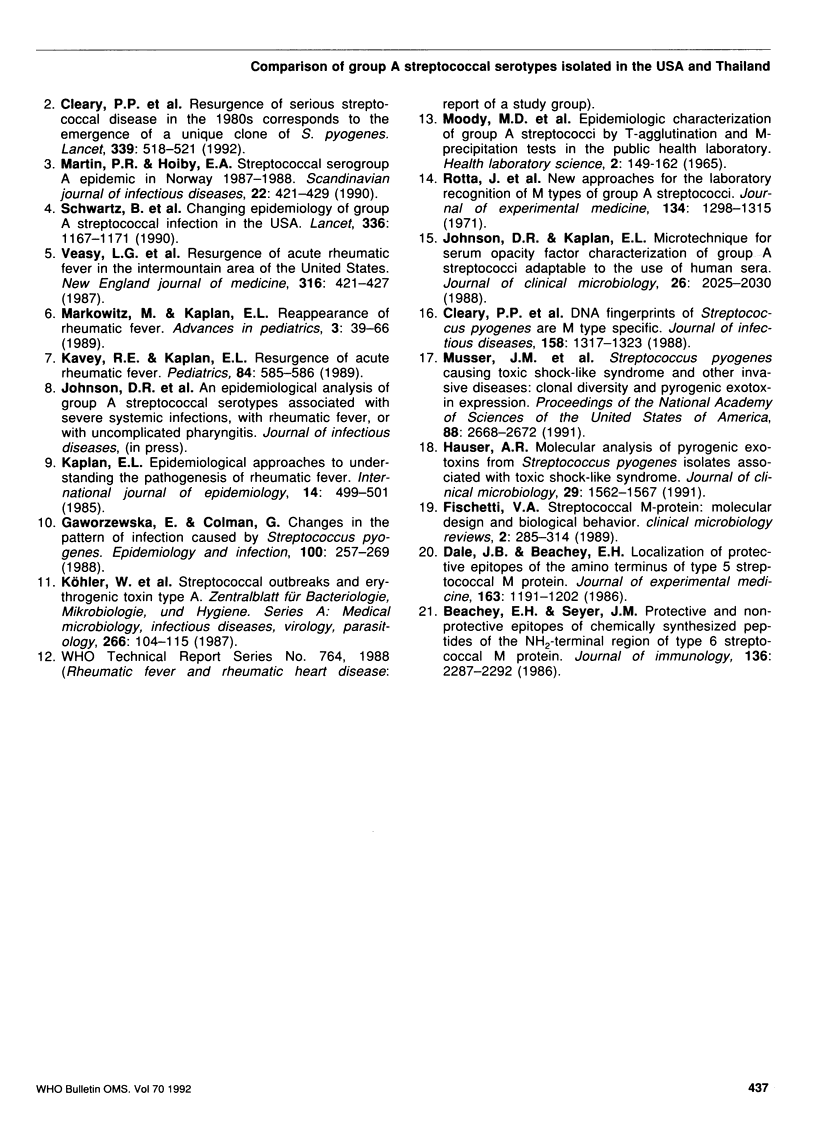
Selected References
These references are in PubMed. This may not be the complete list of references from this article.
- Beachey E. H., Seyer J. M. Protective and nonprotective epitopes of chemically synthesized peptides of the NH2-terminal region of type 6 streptococcal M protein. J Immunol. 1986 Mar 15;136(6):2287–2292. [PubMed] [Google Scholar]
- Cleary P. P., Kaplan E. L., Handley J. P., Wlazlo A., Kim M. H., Hauser A. R., Schlievert P. M. Clonal basis for resurgence of serious Streptococcus pyogenes disease in the 1980s. Lancet. 1992 Feb 29;339(8792):518–521. doi: 10.1016/0140-6736(92)90339-5. [DOI] [PubMed] [Google Scholar]
- Cleary P. P., Kaplan E. L., Livdahl C., Skjold S. DNA fingerprints of Streptococcus pyogenes are M type specific. J Infect Dis. 1988 Dec;158(6):1317–1323. doi: 10.1093/infdis/158.6.1317. [DOI] [PubMed] [Google Scholar]
- Dale J. B., Beachey E. H. Localization of protective epitopes of the amino terminus of type 5 streptococcal M protein. J Exp Med. 1986 May 1;163(5):1191–1202. doi: 10.1084/jem.163.5.1191. [DOI] [PMC free article] [PubMed] [Google Scholar]
- Fischetti V. A. Streptococcal M protein: molecular design and biological behavior. Clin Microbiol Rev. 1989 Jul;2(3):285–314. doi: 10.1128/cmr.2.3.285. [DOI] [PMC free article] [PubMed] [Google Scholar]
- Gaworzewska E., Colman G. Changes in the pattern of infection caused by Streptococcus pyogenes. Epidemiol Infect. 1988 Apr;100(2):257–269. doi: 10.1017/s095026880006739x. [DOI] [PMC free article] [PubMed] [Google Scholar]
- Hauser A. R., Stevens D. L., Kaplan E. L., Schlievert P. M. Molecular analysis of pyrogenic exotoxins from Streptococcus pyogenes isolates associated with toxic shock-like syndrome. J Clin Microbiol. 1991 Aug;29(8):1562–1567. doi: 10.1128/jcm.29.8.1562-1567.1991. [DOI] [PMC free article] [PubMed] [Google Scholar]
- Johnson D. R., Kaplan E. L. Microtechnique for serum opacity factor characterization of group A streptococci adaptable to the use of human sera. J Clin Microbiol. 1988 Oct;26(10):2025–2030. doi: 10.1128/jcm.26.10.2025-2030.1988. [DOI] [PMC free article] [PubMed] [Google Scholar]
- Kaplan E. L. Epidemiological approaches to understanding the pathogenesis of rheumatic fever. Int J Epidemiol. 1985 Dec;14(4):499–501. doi: 10.1093/ije/14.4.499. [DOI] [PubMed] [Google Scholar]
- Kavey R. E., Kaplan E. L. Resurgence of acute rheumatic fever. Pediatrics. 1989 Sep;84(3):585–586. [PubMed] [Google Scholar]
- MOODY M. D., PADULA J., LIZANA D., HALL C. T. EPIDEMIOLOGIC CHARACTERIZATION OF GROUP A STREPTOCOCCI BY T-AGGLUTINATION AND M-PRECIPITATION TESTS IN THE PUBLIC HEALTH LABORATORY. Health Lab Sci. 1965 Jul;2:149–162. [PubMed] [Google Scholar]
- Martin P. R., Høiby E. A. Streptococcal serogroup A epidemic in Norway 1987-1988. Scand J Infect Dis. 1990;22(4):421–429. doi: 10.3109/00365549009027073. [DOI] [PubMed] [Google Scholar]
- Musser J. M., Hauser A. R., Kim M. H., Schlievert P. M., Nelson K., Selander R. K. Streptococcus pyogenes causing toxic-shock-like syndrome and other invasive diseases: clonal diversity and pyrogenic exotoxin expression. Proc Natl Acad Sci U S A. 1991 Apr 1;88(7):2668–2672. doi: 10.1073/pnas.88.7.2668. [DOI] [PMC free article] [PubMed] [Google Scholar]
- Rotta J., Krause R. M., Lancefield R. C., Everly W., Lackland H. New approaches for the laboratory recognition of M types of group A streptococci. J Exp Med. 1971 Nov 1;134(5):1298–1315. doi: 10.1084/jem.134.5.1298. [DOI] [PMC free article] [PubMed] [Google Scholar]
- Schwartz B., Facklam R. R., Breiman R. F. Changing epidemiology of group A streptococcal infection in the USA. Lancet. 1990 Nov 10;336(8724):1167–1171. doi: 10.1016/0140-6736(90)92777-f. [DOI] [PubMed] [Google Scholar]
- Veasy L. G., Wiedmeier S. E., Orsmond G. S., Ruttenberg H. D., Boucek M. M., Roth S. J., Tait V. F., Thompson J. A., Daly J. A., Kaplan E. L. Resurgence of acute rheumatic fever in the intermountain area of the United States. N Engl J Med. 1987 Feb 19;316(8):421–427. doi: 10.1056/NEJM198702193160801. [DOI] [PubMed] [Google Scholar]


